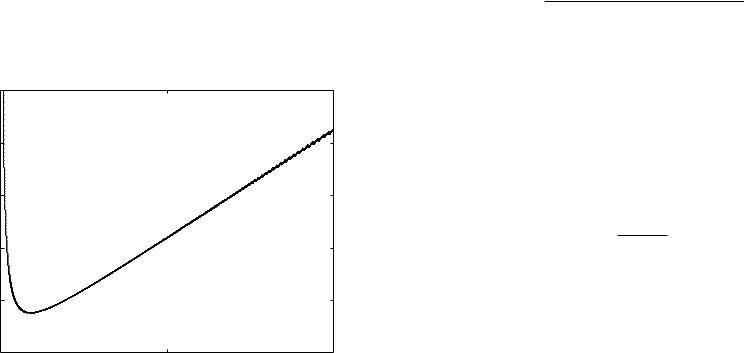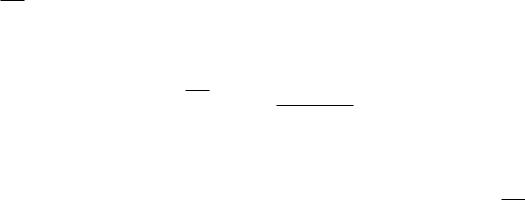Complexity analysis via self-concordance
same assumptions as on page 12–2, plus:
•sublevel sets (of f0, on the feasible set) are bounded
•tf0 + φ is self-concordant with closed sublevel sets
second condition
•holds for LP, QP, QCQP
•may require reformulating the problem, E.G.,
minimize |
P |
n |
|
|
−→ minimize |
P |
n |
|
|
x |
|
|
i=1 xi log xi |
|
i=1 xi log xi |
|
subject to |
F x |
|
g |
subject to |
F x |
|
g, |
|
0 |
•needed for complexity analysis; barrier method works even when self-concordance assumption does not apply
Interior-point methods |
12–19 |
Newton iterations per centering step: from self-concordance theory
#Newton iterations ≤ µtf0(x) + φ(x) − µtf0(x+) − φ(x+) + c
γ
•bound on e ort of computing x+ = x (µt) starting at x = x (t)
•γ, c are constants (depend only on Newton algorithm parameters)
•from duality (with λ = λ (t), ν = ν (t)):
µtf0(x) + φ(x) − µtf0(x+) − φ(x+)
Xm
= |
µtf0(x) − µtf0(x+) + |
log(−µtλifi(x+)) − m log µ |
|
i=1 |
|
|
m |
≤ |
µtf0(x) − µtf0(x+) − µt |
X |
λifi(x+) − m − m log µ |
i=1
≤ µtf0(x) − µtg(λ, ν) − m − m log µ = m(µ − 1 − log µ)
Interior-point methods |
12–20 |
total number of Newton iterations (excluding first centering step)
|
m/(t(0)ǫ)) |
|
m(µ |
|
1 |
log µ) |
#Newton iterations ≤ N = |
log( |
|
|
− |
− |
|
+ c |
log µ |
|
|
γ |
|
5 104 |
|
|
|
|
4 104 |
|
figure shows N for typical values of γ, c, |
|
|
3 104 |
|
|
m |
|
N |
|
m = 100, |
= 105 |
2 104 |
|
|
t(0)ǫ |
|
1 104 |
|
|
|
|
01 |
1.1 |
1.2 |
|
|
|
µ |
|
|
|
•confirms trade-o in choice of µ
•in practice, #iterations is in the tens; not very sensitive for µ ≥ 10
Interior-point methods |
12–21 |
polynomial-time complexity of barrier method
• for µ = 1 + 1/√m:
N = O √m log m/t(0)
ǫ
•number of Newton iterations for fixed gap reduction is O(√m)
•multiply with cost of one Newton iteration (a polynomial function of problem dimensions), to get bound on number of flops
this choice of µ optimizes worst-case complexity; in practice we choose µ fixed (µ = 10, . . . , 20)
Interior-point methods |
12–22 |
Generalized inequalities
minimize |
f0(x) |
subject to |
fi(x) Ki 0, i = 1, . . . , m |
|
Ax = b |
•f0 convex, fi : Rn → Rki, i = 1, . . . , m, convex with respect to proper cones Ki Rki
•fi twice continuously di erentiable
•A Rp×n with rank A = p
•we assume p is finite and attained
•we assume problem is strictly feasible; hence strong duality holds and dual optimum is attained
examples of greatest interest: SOCP, SDP
Interior-point methods |
12–23 |
Generalized logarithm for proper cone
ψ : Rq → R is generalized logarithm for proper cone K Rq if:
• dom ψ = int K and 2ψ(y) 0 for y K 0
• ψ(sy) = ψ(y) + θ log s for y K 0, s > 0 (θ is the degree of ψ)
examples
• nonnegative orthant K = R+n : ψ(y) = |
P |
n |
i=1 log yi, with degree θ = n |
• |
|
positive semidefinite cone K = S+n : |
|
ψ(Y ) = log det Y |
|
(θ = n) |
• second-order cone K = {y Rn+1 | (y12 + · · · + yn2 )1/2 ≤ yn+1}:
ψ(y) = log(yn2 |
+1 − y12 − · · · − yn2 ) (θ = 2) |
Interior-point methods |
12–24 |
properties (without proof): for y K 0, |
|
|
|
ψ(y) K 0, |
yT ψ(y) = θ |
|
n |
|
|
|
• nonnegative orthant R+n : ψ(y) = Pi=1 log yi |
|
T |
ψ(y) = n |
ψ(y) = (1/y1, . . . , 1/yn), |
y |
|
• positive semidefinite cone S+n : ψ(Y ) = log det Y |
ψ(Y ) = Y −1, |
tr(Y ψ(Y )) = n |
•second-order cone K = {y Rn+1 | (y12 + · · · + yn2 )1/2 ≤ yn+1}:
|
− |
|
|
− · · · − |
|
|
−y1 |
|
|
|
|
|
|
y |
|
|
|
ψ(y) = y2 |
|
|
2 |
y2 |
|
|
. |
|
, yT ψ(y) = 2 |
|
y2 |
|
|
− |
yn |
|
n+1 |
|
1 |
|
|
n |
|
|
|
|
|
|
|
|
|
|
|
n+1 |
|
Interior-point methods |
12–25 |
Logarithmic barrier and central path
logarithmic barrier for f1(x) K1 0, . . . , fm(x) Km 0:
Xm
φ(x) = − ψi(−fi(x)), dom φ = {x | fi(x) Ki 0, i = 1, . . . , m}
i=1
•ψi is generalized logarithm for Ki, with degree θi
•φ is convex, twice continuously di erentiable
central path: {x (t) | t > 0} where x (t) solves
minimize |
tf0(x) + φ(x) |
subject to |
Ax = b |
Interior-point methods |
12–26 |
Dual points on central path
x = x (t) if there exists w Rp,
Xm
t f0(x) + Dfi(x)T ψi(−fi(x)) + AT w = 0
i=1
(Dfi(x) Rki×n is derivative matrix of fi)
• therefore, x (t) minimizes Lagrangian L(x, λ (t), ν (t)), where
1 |
|
|
|
w |
λi (t) = |
|
ψi(−fi(x (t))), |
ν (t) = |
|
t |
t |
• from properties of ψi: λi (t) Ki 0, with duality gap |
|
|
|
|
|
m |
|
|
|
|
|
X |
|
|
f0(x (t)) − g(λ (t), ν (t)) = (1/t) |
θi |
i=1
Interior-point methods |
12–27 |
example: semidefinite programming (with Fi Sp)
minimize |
cT x |
|
n |
subject to |
F (x) = Pi=1 xiFi + G 0 |
•logarithmic barrier: φ(x) = log det(−F (x)−1)
•central path: x (t) minimizes tcT x − log det(−F (x)); hence
tci − tr(FiF (x (t))−1) = 0, i = 1, . . . , n
• dual point on central path: Z (t) = −(1/t)F (x (t))−1 is feasible for
maximize |
tr(GZ) |
subject to |
tr(FiZ) + ci = 0, i = 1, . . . , n |
Z0
•duality gap on central path: cT x (t) − tr(GZ (t)) = p/t
Interior-point methods |
12–28 |




